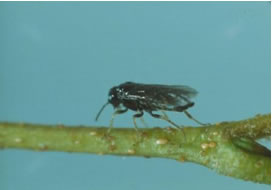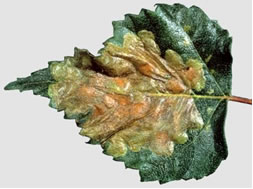Birch leafminer
Birch leafminers are sawflies (family Tenthredinidae) native to Europe and were introduced to Canadian forests between 1920 and 1960.
Birch leafminers attack all species of birch and have been recorded in all provinces and territories except Nunavut. There are a number of natural enemies, such as parasitic wasps.
Quick facts
- Each of the five species of sawflies known as birch leafminers, including the birch leafminer and the ambermarked birch leafminer, can be identified by markings on the larvae and adults, as well as by the shape and colour of damage.
- Larvae feed between the surfaces of a leaf. Damage appears as small brown or reddish-brown irregular shaped patches (a leaf “mine”) on the upper side of a leaf.
- Some species can reproduce without males.
- Outbreaks mostly happen in urban areas.

Impacts
Birch leafminers have few known impacts on the health of a forest. While they cause aesthetic damage to birch trees, they usually do not kill the tree.

- Trees can tolerate small populations and damage often goes unnoticed.
- Depending on the species, damage to a tree appears in the spring or late summer.
- For some species, the mine often causes the leaf’s edge to curl.
- Severe damage will make foliage appear brown, similar in colour to late fall.
- Most species attack fully formed leaves, but one species attacks new shoots.
- Repeated attacks may weaken a tree and make it more likely to be attacked by other insects.
CFS scientific research
Scientists at the Canadian Forest Service (CFS) have identified that the lifecycle of the birch leafminer can take five to six weeks and involves:
- First generation adults appearing in the spring when new leaves grow, or later in the spring after leaves have fully formed.
- Females deposit eggs inside new leaves by cutting into the leaf’s surface using a special egg-laying structure that looks and acts like a saw.
- Eggs hatch in 4 to 14 days and once hatched feed within the leaf for 8 to 12 days.
- After feeding, young larvae either exit the leaf as mature larvae or create a cocoon within the leaf. Larvae that leave the leaf fall to the ground and create cocoons in the soil.
- Species with multiple generations per year emerge as adults within two weeks, other species remain underground until the next spring.
Some other details about birch leafminers:
- They are active between May and mid-September.
- Depending on the species and location, each species can have one, two, three or four generations per year.
- The birch leafminer can withstand the winter by staying underground, or inside its mine on the surface of the ground, underneath the snow.
- Birch leafminer outbreaks have been controlled in Alberta and Quebec by the introduction of parasitic wasps from Europe.
- One species is controlled by a native parasitic wasp that adopted the leafminer as a host. This wasp has been used as a biological control agent in the United States and in Canada.
Working collaboratively to develop solutions
Natural Resources Canada, based on the work of its Canadian Forest Service scientists, has increased our understanding of the disruption caused by birch leafminers. Currently, no research involving this species is being conducted as the birch leafminer is considered to be a minor pest.
Want more information on the birch leafminer?
Contact Chris MacQuarrie of the Great Lakes Forestry Centre.
Page details
- Date modified: